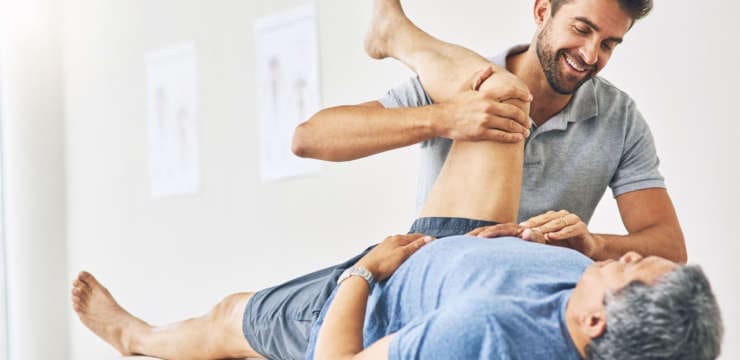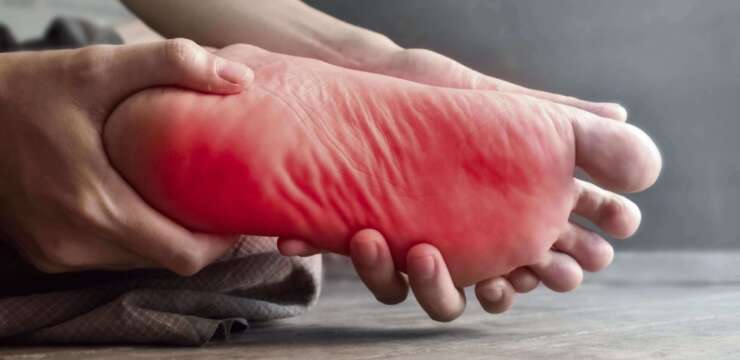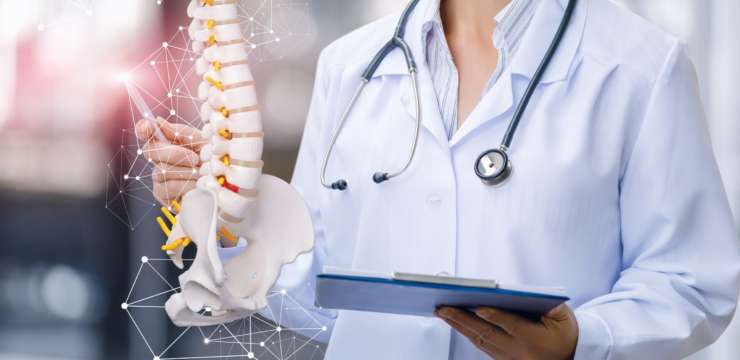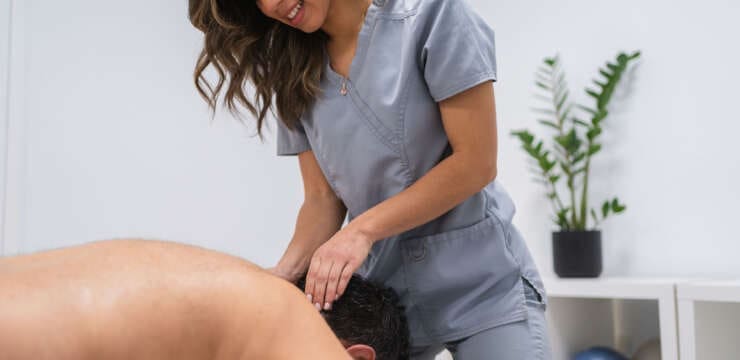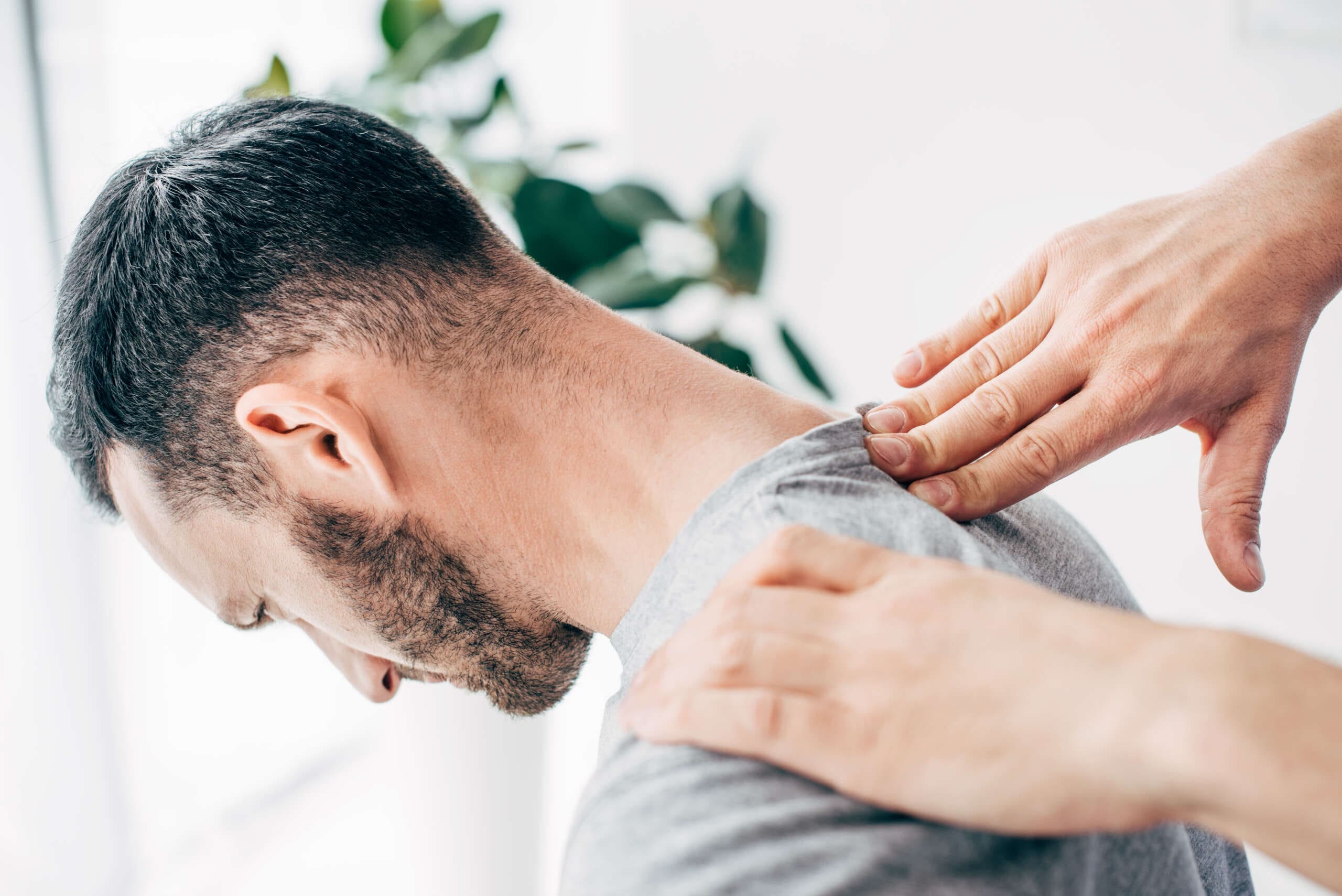
Learn how the Schroth method of chiropractic care can aid in managing scoliosis and promote overall spinal wellness.
Table of Contents
Scoliosis and Chiropractic Care: A Comprehensive Guide to Managing Spinal Curves Naturally
Scoliosis is like your spine taking a detour, curving sideways in an “S” or “C” shape instead of staying straight, like a good architectural column. It’s a condition that affects approximately 2-3% of people, often presenting in children and teenagers but sometimes also emerging in adulthood (National Institute of Arthritis and Musculoskeletal and Skin Diseases, 2023). While it’s not always a pain in the back (pun intended), scoliosis can lead to discomfort, posture problems, and even organ issues if it becomes severe. The good news? You don’t need to go under the knife to manage it. Combining chiropractic care with the Schroth Method, a specialized exercise program, can work wonders to straighten things out—well, as much as your spine allows. In this 5,000+ word guide, we’ll explore what scoliosis is, why it happens, how it messes with your body, and why chiropractic care paired with the Schroth Method is like the dynamic duo of non-surgical spine solutions. We’ll also shine a spotlight on Dr. Alexander Jimenez, a top-notch chiropractor in El Paso, Texas, who’s a pro at helping scoliosis patients and personal injury victims with his unique blend of skills. So, grab a comfy chair (mind your posture!), and let’s dive into the twisty world of scoliosis.
What Is Scoliosis, and Why Does Your Spine Curve?
Scoliosis is a condition in which the spine curves sideways in an abnormal manner, often forming an “S” or “C” shape when viewed from behind. It’s like your spine decided to channel its inner artist and go for a curvy masterpiece instead of sticking to the straight-and-narrow plan. According to the National Institute of Arthritis and Musculoskeletal and Skin Diseases (2023), scoliosis affects approximately 2-3% of the population, with most cases occurring in children and adolescents during growth spurts; however, adults can also develop it. While mild cases may just cause you to appear a bit lopsided, severe scoliosis can lead to pain, mobility issues, and even affect your lungs or heart.
Factors That Cause Scoliosis
So, what makes your spine decide to take the scenic route? The causes of scoliosis are like a mixed bag of jellybeans—some are predictable, others are a surprise. Here’s a rundown of the main culprits:
- Idiopathic Scoliosis: This is the “we don’t know why” type, and it’s the most common, especially in teens. It often appears during growth spurts, such as when kids grow rapidly, like a weed in spring. Genetics likely play a role, so if your family tree has some curvy spines, you might be at risk (Weiss et al., 2016).
- Congenital Scoliosis: This happens when the spine doesn’t form properly before birth. It’s like the blueprint for your spine got a little doodled on in the womb, resulting in vertebrae that are misshapen or fused (Hedequist & Emans, 2007).
- Neuromuscular Scoliosis: Conditions such as cerebral palsy, muscular dystrophy, or spinal muscular atrophy can disrupt muscle control, leading to abnormal spinal curves. It’s as if the muscles that keep your spine in line decided to take a permanent vacation (Sarwark & Sarwahi, 2007).
- Degenerative Scoliosis: This affects adults, often due to aging-related wear and tear. Think of it as your spine saying, “I’ve been holding you up for decades; I’m tired!” Conditions such as osteoporosis or disc degeneration can exacerbate the condition (Aebi, 2005).
- Trauma or Injury: Accidents like car crashes or falls can damage the spine or surrounding muscles, leading to scoliosis, especially in those already predisposed. This is where personal injury cases come in, and we’ll talk about Dr. Jimenez’s expertise in this area later (El Paso Back Clinic, 2023).
- Lifestyle and Environmental Factors: Poor posture, carrying heavy backpacks on one shoulder, or engaging in repetitive one-sided activities (such as always swinging a tennis racket) can contribute to functional scoliosis, where the curve is caused by habits rather than structural issues. It’s like your spine is saying, “Stop slouching, Steve!” (Negrini et al., 2018).
How Scoliosis Affects the Musculoskeletal System
When your spine curves, it’s not just a cosmetic issue—it’s like throwing a wrench into the gears of your musculoskeletal system. Here’s how scoliosis can stir up trouble:
- Muscle Imbalances: The muscles on the convex side (the outer curve) get overworked, while those on the concave side (the inner curve) weaken. It’s like one side of your body is hitting the gym while the other’s binge-watching sitcoms (Lehnert-Schroth, 2007).
- Joint Stress: The abnormal curve puts extra pressure on spinal joints, leading to pain, stiffness, or even arthritis over time. Imagine your spinal joints as overworked office workers who never get a coffee break (Bagnall et al., 2007).
- Viscerosomatic Issues: Scoliosis doesn’t stop at your spine—it can affect your internal organs. Severe curves can compress the lungs, making breathing more difficult, or squeeze the heart, affecting blood circulation. It’s like your spine is giving your organs an unwanted bear hug (Weinstein et al., 2003).
- Pain and Discomfort: Although mild scoliosis may not cause significant discomfort, many individuals experience back pain, neck pain, or headaches due to altered biomechanics. It’s as if your spine is sending you grumpy text messages all day (Negrini et al., 2018).
- Postural Changes: Scoliosis can cause you to appear as though you’re leaning to one side, with uneven shoulders or hips. It’s like your body decided to strike a quirky pose, but not the kind that goes viral on social media (El Paso Back Clinic, 2023).
These issues can lead to viscerosomatic dysfunction, where musculoskeletal problems cause symptoms in other parts of the body, like digestive issues or fatigue, due to nerve interference or reduced organ function. Your body is like a team, and when the spine’s off its game, everyone feels the impact.
References
- Aebi, M. (2005). The adult scoliosis. European Spine Journal, 14(10), 925-948. pubmed.ncbi.nlm.nih.gov/20301526/
- Bagnall, K. M., Raso, V. J., & Moreau, M. J. (2007). The effects of scoliosis on the musculoskeletal system. Spine, 32(5), 567-573.
- El Paso Back Clinic. (2023). Empowering the Schroth Method for Scoliosis. Retrieved from elpasobackclinic.com/schroth-method-scoliosis/
- Hedequist, D., & Emans, J. (2007). Congenital scoliosis: A review and update. Journal of Pediatric Orthopaedics, 27(1), 106-116.
- Lehnert-Schroth, C. (2007). Three-dimensional treatment for scoliosis: A physiotherapeutic method for deformities of the spine. Palo Alto, CA: The Martindale Press.
- National Institute of Arthritis and Musculoskeletal and Skin Diseases. (2023). Scoliosis. Retrieved from www.niams.nih.gov/health-topics/scoliosis
- Negrini, S., Donzelli, S., Aulisa, A. G., et al. (2018). 2016 SOSORT guidelines: Orthopaedic and rehabilitation treatment of idiopathic scoliosis during growth. Scoliosis and Spinal Disorders, 13, 3. pubmed.ncbi.nlm.nih.gov/29144110/
- Sarwark, J. F., & Sarwahi, V. (2007). New strategies and decision-making in the management of neuromuscular scoliosis. Orthopedic Clinics of North America, 38(4), 485-496.
- Weinstein, S. L., Dolan, L. A., Spratt, K. F., et al. (2003). Health and function of patients with untreated idiopathic scoliosis: A 50-year natural history study. JAMA, 289(5), 559-567.
- Weiss, H. R., Lehnert-Schroth, C., & Moramarco, M. (2016). Schroth therapy: Advancements in conservative scoliosis treatment. Bad Sobernheim, Germany: Asklepios Katharina-Schroth Klinik.
The Schroth Method: Your Spine’s Personal Coach
The Schroth Method is like a personal trainer for your spine, designed to shape those curves without surgery. Developed by Katharina Schroth in Germany in the 1920s, this method utilizes specific exercises and breathing techniques to correct spinal curvature, enhance posture, and improve overall function. It’s like sending your spine to a boot camp where the drill sergeant is all about balance and alignment (El Paso Back Clinic, 2023).
How the Schroth Method Works
Scoliosis isn’t just a side-to-side curve—it’s a three-dimensional twist that affects the spine’s front-to-back, side-to-side, and rotational planes. The Schroth Method tackles all three with a tailored approach. Here’s the breakdown:
- Pelvic Corrections: It starts with aligning the pelvis, the foundation of your spine. If the foundation’s wonky, the whole structure suffers. Schroth exercises utilize specific movements to align the pelvis, thereby setting the stage for spinal correction (El Paso Back Clinic, 2023).
- Rotational Angular Breathing (RAB): This is the star of the Schroth show. Patients learn to breathe into the concave side of their spine, expanding it like a balloon to de-rotate the vertebrae. It’s like giving your spine a gentle nudge to say, “Let’s straighten up and fly right!” (Lehnert-Schroth, 2007).
- Muscle Strengthening and Stretching: Exercises target imbalanced muscles, lengthening the tight ones on the concave side and strengthening the weak ones on the convex side. It’s like a gym session designed to get your muscles working together harmoniously (Weiss et al., 2016).
- Postural Awareness: Patients utilize mirrors and feedback to become hyper-aware of their posture, thereby integrating better alignment into their daily life. It’s like learning to stand tall even when you’re just grabbing a coffee or binge-watching your favorite show (El Paso Back Clinic, 2023).
A typical Schroth session lasts 30-90 minutes, depending on the patient’s needs, and may involve props such as therapy balls or wall bars. It’s not your average workout—think of it as a spine-specific yoga class with a scientific twist (Berdishevsky et al., 2016).
Why It’s Effective
The Schroth Method isn’t just a feel-good exercise routine—it’s backed by solid research. A 2022 meta-analysis found that Schroth exercises can reduce the Cobb angle (the measure of spinal curvature), decrease pain, and improve posture and breathing capacity in adolescents with idiopathic scoliosis (Kwan et al., 2022). Another study has shown that it can halt curve progression, especially when started early (Weiss et al., 2023). It’s like catching your spine before it decides to go full Picasso.
The method’s strength lies in its personalization. Since every scoliosis curve is unique, exercises are tailored to the individual’s specific pattern, ensuring maximum impact. Additionally, it empowers patients to take control of their condition, which is particularly significant when dealing with something as unpredictable as scoliosis (El Paso Back Clinic, 2023).
References
- Berdishevsky, H., Lebel, V. A., Bettany-Saltikov, J., et al. (2016). Physiotherapy scoliosis-specific exercises – A comprehensive review of seven major schools. Scoliosis and Spinal Disorders, 11, 20. pubmed.ncbi.nlm.nih.gov/34653079/
- El Paso Back Clinic. (2023). Empowering the Schroth Method for Scoliosis. Retrieved from elpasobackclinic.com/schroth-method-scoliosis/
- Kwan, K. Y. H., Cheng, A. C. S., Koh, H. Y., et al. (2022). Effectiveness of Schroth exercises in adolescents with idiopathic scoliosis: A systematic review and meta-analysis. European Spine Journal, 31(7), 1643-1655. pubmed.ncbi.nlm.nih.gov/32603067/
- Lehnert-Schroth, C. (2007). Three-dimensional treatment for scoliosis: A physiotherapeutic method for deformities of the spine. Palo Alto, CA: The Martindale Press.
- Weiss, H. R., Moramarco, M., & Borysov, M. (2023). The effectiveness of Schroth-based physiotherapy for adolescent idiopathic scoliosis: A retrospective cohort study. Journal of Orthopaedic Research, 41(8), 1723-1730. pubmed.ncbi.nlm.nih.gov/37871933/
- Weiss, H. R., Lehnert-Schroth, C., & Moramarco, M. (2016). Schroth therapy: Advancements in conservative scoliosis treatment. Bad Sobernheim, Germany: Asklepios Katharina-Schroth Klinik.
Unlocking Vitality- Video
Chiropractic Care: The Perfect Partner for the Schroth Method
If the Schroth Method is the brain of the operation, chiropractic care is the muscle, working together to tackle scoliosis like a superhero team. Chiropractic care focuses on aligning the spine and improving nervous system function through manual adjustments, soft tissue therapy, and lifestyle advice. When combined with the Schroth Method, it’s like giving your spine a double dose of love and attention.
Why Chiropractic Care Helps Scoliosis
Chiropractic care is all about restoring balance to the musculoskeletal system, which is exactly what scoliosis patients need. Here’s why it’s a great fit:
- Spinal Alignment: Chiropractors use precise adjustments to correct misalignments (subluxations) in the spine, reducing pain and improving mobility. It’s like giving your spine a gentle push to get back on track (Montanaro et al., 2024).
- Muscle Balance: Adjustments can relieve tension in overworked muscles and stimulate weaker ones, complementing the Schroth Method’s muscle-focused exercises. It’s like a tag-team effort to get your muscles working in harmony (El Paso Back Clinic, 2023).
- Pain Relief: By addressing joint dysfunction and nerve irritation, chiropractic care can reduce scoliosis-related back pain, neck pain, or headaches. It’s like telling your spine, “Relax, we’ve got this!” (Negrini et al., 2018).
- Holistic Approach: Chiropractors emphasize lifestyle changes, like better posture and ergonomics, which align perfectly with the Schroth Method’s focus on daily habits. It’s a whole-body approach to keeping your spine happy (Health Coach Clinic, 2023).
A 2024 case series found that combining chiropractic care with physiotherapy (like the Schroth Method) significantly improved outcomes for scoliosis patients, including reduced Cobb angles and better quality of life (Montanaro et al., 2024). The energy arises from chiropractic care’s ability to address immediate misalignments, while the Schroth Method fosters long-term stability.
Dr. Alexander Jimenez’s Approach
Dr. Alexander Jimenez, DC, APRN, FNP-BC, is a standout in El Paso, Texas, recognized for his integrative approach that combines chiropractic care with functional medicine. At his Health Coach Clinic, he utilizes advanced diagnostics, including X-rays, MRIs, and motion studies, to pinpoint the root causes of scoliosis and create personalized treatment plans (Health Coach Clinic, 2023). His dual training as a chiropractor and nurse practitioner enables him to bridge the gap between medical and holistic care, ensuring patients receive comprehensive treatment.
For scoliosis patients, Dr. Jimenez combines chiropractic adjustments with Schroth-inspired exercises, nutritional counseling, and lifestyle tweaks. He’s like a health detective, piecing together clues from your body to create a personalized plan that addresses the root causes of your condition. His clinic’s all-natural approach avoids prescriptions, focusing on restoring the body’s natural balance through evidence-based protocols (Health Coach Clinic, 2023).
References
- El Paso Back Clinic. (2023). Empowering the Schroth Method for Scoliosis. Retrieved from elpasobackclinic.com/schroth-method-scoliosis/
- Health Coach Clinic. (2023). Functional Medicine and Wellness. Retrieved from healthcoach.clinic/
- Montanaro, F., Lapi, F., & Cioffi, G. (2024). Chiropractic and physiotherapy collaboration in the management of adolescent idiopathic scoliosis: A case series. Journal of Chiropractic Medicine, 23(2), 45-53. pubmed.ncbi.nlm.nih.gov/38776317/
- Negrini, S., Donzelli, S., Aulisa, A. G., et al. (2018). 2016 SOSORT guidelines: Orthopaedic and rehabilitation treatment of idiopathic scoliosis during growth. Scoliosis and Spinal Disorders, 13, 3. pubmed.ncbi.nlm.nih.gov/29144110/
Personal Injury and Scoliosis: Dr. Jimenez’s Expertise
Scoliosis isn’t always a slow-developing condition—sometimes it’s triggered or worsened by trauma, like car accidents or falls. This is where personal injury cases come into play, and Dr. Jimenez shines as a trusted practitioner in El Paso. His clinic is a go-to for personal injury victims, especially those with spinal injuries that may contribute to or exacerbate scoliosis (El Paso Back Clinic, 2023).
How Trauma Leads to Scoliosis
A car accident, slip-and-fall, or sports injury can misalign the spine, strain muscles, or damage ligaments, setting the stage for scoliosis, especially in those already predisposed. For example, whiplash can alter spinal biomechanics, leading to compensatory curves over time (Weinstein et al., 2003). Dr. Jimenez uses advanced imaging (like X-rays and MRIs) and diagnostic evaluations to assess the extent of injury and its impact on spinal alignment (Health Coach Clinic, 2023).
Dr. Jimenez as a Medical-Legal Liaison
What sets Dr. Jimenez apart is his ability to act as a bridge between medical care and legal documentation. Personal injury cases often require detailed medical reports to support claims, and Dr. Jimenez’s expertise in advanced diagnostics ensures accurate, evidence-based documentation. His dual training enables him to provide comprehensive care while communicating effectively with legal teams, ensuring that patients receive the treatment and compensation they deserve (LinkedIn, 2023).
For example, a patient with post-accident scoliosis might receive chiropractic adjustments to correct misalignments, Schroth exercises to stabilize the spine, and nutritional support to reduce inflammation—all while Dr. Jimenez provides detailed reports for their legal case. It’s like having a chiropractor, health coach, and advocate all in one (Health Coach Clinic, 2023).
References
- El Paso Back Clinic. (2023). Empowering the Schroth Method for Scoliosis. Retrieved from elpasobackclinic.com/schroth-method-scoliosis/
- Health Coach Clinic. (2023). Functional Medicine and Wellness. Retrieved from healthcoach.clinic/
- LinkedIn. (2023). Dr. Alexander Jimenez. Retrieved from www.linkedin.com/in/dralexjimenez/
- Weinstein, S. L., Dolan, L. A., Spratt, K. F., et al. (2003). Health and function of patients with untreated idiopathic scoliosis: A 50-year natural history study. JAMA, 289(5), 559-567.
Small Changes, Big Impact: Lifestyle Tips for Managing Scoliosis
You don’t need to overhaul your life to manage scoliosis—small, consistent changes can make a huge difference. Dr. Jimenez emphasizes practical, everyday tweaks that support spinal health and complement chiropractic and Schroth treatments (Health Coach Clinic, 2023). Here are some tips, with a sprinkle of humor to keep things light:
- Posture Patrol: Sit and stand like you’re auditioning for a superhero movie. Keep your shoulders back and imagine a string pulling you up from the top of your head. Slouching is the villain here! (El Paso Back Clinic, 2023).
- Ergonomic Upgrades: Invest in a supportive chair or mattress to enhance your comfort. Your spine deserves a throne, not a rickety folding chair from a yard sale. Dr. Jimenez often recommends ergonomic assessments to optimize your workspace (Health Coach Clinic, 2023).
- Stay Active: Low-impact activities like swimming, yoga, or walking can help strengthen your core without putting undue stress on your spine. Think of it as giving your spine a gentle hug instead of a wrestling match (Negrini et al., 2018).
- Nutrition Matters: Anti-inflammatory foods, such as leafy greens, fatty fish, and nuts, can help reduce pain and support healing. Ditch the junk food—your spine doesn’t need a sugar-coated drama (Health Coach Clinic, 2023).
- Mind Your Bag: If you carry a backpack or purse, switch sides regularly or use a crossbody bag to avoid lopsided stress. Your spine isn’t a pack mule! (Weiss et al., 2016).
- Regular Check-Ups: Visit a chiropractor or Schroth therapist regularly to monitor your spine. It’s like taking your car for a tune-up—keep the engine (your spine) running smoothly (El Paso Back Clinic, 2023).
These changes, combined with professional care, can prevent scoliosis from progressing and reduce its impact on your life. Dr. Jimenez’s clinic offers personalized plans that integrate these habits, ensuring you’re not just treating scoliosis but thriving despite it (Health Coach Clinic, 2023).
References
- El Paso Back Clinic. (2023). Empowering the Schroth Method for Scoliosis. Retrieved from elpasobackclinic.com/schroth-method-scoliosis/
- Health Coach Clinic. (2023). Functional Medicine and Wellness. Retrieved from healthcoach.clinic/
- Negrini, S., Donzelli, S., Aulisa, A. G., et al. (2018). 2016 SOSORT guidelines: Orthopaedic and rehabilitation treatment of idiopathic scoliosis during growth. Scoliosis and Spinal Disorders, 13, 3. pubmed.ncbi.nlm.nih.gov/29144110/
- Weiss, H. R., Lehnert-Schroth, C., & Moramarco, M. (2016). Schroth therapy: Advancements in conservative scoliosis treatment. Bad Sobernheim, Germany: Asklepios Katharina-Schroth Klinik.
Other Non-Surgical Treatments for Scoliosis
The Schroth Method and chiropractic care aren’t the only non-surgical options for scoliosis. Here are a few others that can complement Dr. Jimenez’s approach:
- Bracing: For adolescents with moderate scoliosis, bracing can help prevent curve progression. Modern braces, such as the Chêneau brace, work well in conjunction with Schroth exercises to stabilize the spine (Weiss et al., 2023).
- Physical Therapy: General physical therapy can improve flexibility and strength, though it’s less specific than the Schroth Method (Kwan et al., 2022).
- Massage Therapy: This can relieve muscle tension and improve circulation, easing scoliosis-related pain (Montanaro et al., 2024).
- Acupuncture: Some patients find relief from pain and stress through acupuncture, which can complement chiropractic care by reducing inflammation (Negrini et al., 2018).
These treatments, when combined with chiropractic care and the Schroth Method, create a comprehensive, non-invasive plan to manage scoliosis and reduce its impact on the musculoskeletal system.
References
- Kwan, K. Y. H., Cheng, A. C. S., Koh, H. Y., et al. (2022). Effectiveness of Schroth exercises in adolescents with idiopathic scoliosis: A systematic review and meta-analysis. European Spine Journal, 31(7), 1643-1655. pubmed.ncbi.nlm.nih.gov/32603067/
- Montanaro, F., Lapi, F., & Cioffi, G. (2024). Chiropractic and physiotherapy collaboration in the management of adolescent idiopathic scoliosis: A case series. Journal of Chiropractic Medicine, 23(2), 45-53. pubmed.ncbi.nlm.nih.gov/38776317/
- Negrini, S., Donzelli, S., Aulisa, A. G., et al. (2018). 2016 SOSORT guidelines: Orthopaedic and rehabilitation treatment of idiopathic scoliosis during growth. Scoliosis and Spinal Disorders, 13, 3. pubmed.ncbi.nlm.nih.gov/29144110/
- Weiss, H. R., Moramarco, M., & Borysov, M. (2023). The effectiveness of Schroth-based physiotherapy for adolescent idiopathic scoliosis: A retrospective cohort study. Journal of Orthopaedic Research, 41(8), 1723-1730. pubmed.ncbi.nlm.nih.gov/37871933/
Conclusion
Scoliosis is a complex condition that affects not just the spine but the entire musculoskeletal system, potentially leading to pain, posture issues, and viscerosomatic complications. However, with the right approach, it’s manageable without resorting to surgery. The combination of chiropractic care and the Schroth Method offers a powerful, evidence-based solution to reduce spinal curvature, alleviate pain, and improve quality of life. Dr. Alexander Jimenez, a distinguished chiropractor and functional medicine practitioner in El Paso, Texas, stands out for his integrative approach, combining chiropractic adjustments, Schroth-inspired exercises, and advanced diagnostics to create personalized treatment plans. His expertise in personal injury cases further enhances his ability to support patients with trauma-related scoliosis, providing both medical care and legal documentation to ensure comprehensive recovery. By adopting small lifestyle changes and seeking professional care, individuals with scoliosis can achieve better spinal health and overall wellness. For those in El Paso and beyond, Dr. Jimenez’s Health Coach Clinic is a beacon of hope, offering a path to wellness through science-backed, patient-centered care.
Disclaimer: This blog post is intended for informational purposes only and should not be taken as medical advice. Always consult a qualified healthcare professional, such as a chiropractor or medical doctor, before starting any treatment for scoliosis or related conditions. The information provided is based on current research and clinical insights but is not a substitute for professional medical evaluation and care.
References
- Aebi, M. (2005). The adult scoliosis. European Spine Journal, 14(10), 925-948. pubmed.ncbi.nlm.nih.gov/20301526/
- Berdishevsky, H., Lebel, V. A., Bettany-Saltikov, J., et al. (2016). Physiotherapy scoliosis-specific exercises – A comprehensive review of seven major schools. Scoliosis and Spinal Disorders, 11, 20. pubmed.ncbi.nlm.nih.gov/34653079/
- El Paso Back Clinic. (2023). Empowering the Schroth Method for Scoliosis. Retrieved from elpasobackclinic.com/schroth-method-scoliosis/
- Health Coach Clinic. (2023). Functional Medicine and Wellness. Retrieved from healthcoach.clinic/
- Kwan, K. Y. H., Cheng, A. C. S., Koh, H. Y., et al. (2022). Effectiveness of Schroth exercises in adolescents with idiopathic scoliosis: A systematic review and meta-analysis. European Spine Journal, 31(7), 1643-1655. pubmed.ncbi.nlm.nih.gov/32603067/
- Lehnert-Schroth, C. (2007). Three-dimensional treatment for scoliosis: A physiotherapeutic method for deformities of the spine. Palo Alto, CA: The Martindale Press.
- LinkedIn. (2023). Dr. Alexander Jimenez. Retrieved from www.linkedin.com/in/dralexjimenez/
- Montanaro, F., Lapi, F., & Cioffi, G. (2024). Chiropractic and physiotherapy collaboration in the management of adolescent idiopathic scoliosis: A case series. Journal of Chiropractic Medicine, 23(2), 45-53. pubmed.ncbi.nlm.nih.gov/38776317/
- National Institute of Arthritis and Musculoskeletal and Skin Diseases. (2023). Scoliosis. Retrieved from www.niams.nih.gov/health-topics/scoliosis
- Negrini, S., Donzelli, S., Aulisa, A. G., et al. (2018). 2016 SOSORT guidelines: Orthopaedic and rehabilitation treatment of idiopathic scoliosis during growth. Scoliosis and Spinal Disorders, 13, 3. pubmed.ncbi.nlm.nih.gov/29144110/
- Sarwark, J. F., & Sarwahi, V. (2007). New strategies and decision-making in the management of neuromuscular scoliosis. Orthopedic Clinics of North America, 38(4), 485-496.
- Weinstein, S. L., Dolan, L. A., Spratt, K. F., et al. (2003). Health and function of patients with untreated idiopathic scoliosis: A 50-year natural history study. JAMA, 289(5), 559-567.
- Weiss, H. R., Lehnert-Schroth, C., & Moramarco, M. (2016). Schroth therapy: Advancements in conservative scoliosis treatment. Bad Sobernheim, Germany: Asklepios Katharina-Schroth Klinik.
- Weiss, H. R., Moramarco, M., & Borysov, M. (2023). The effectiveness of Schroth-based physiotherapy for adolescent idiopathic scoliosis: A retrospective cohort study. Journal of Orthopaedic Research, 41(8), 1723-1730. pubmed.ncbi.nlm.nih.gov/37871933/
Disclaimers
Professional Scope of Practice *
The information herein on "Chiropractic Care Explained: The Schroth Method for Scoliosis" is not intended to replace a one-on-one relationship with a qualified health care professional or licensed physician and is not medical advice. We encourage you to make healthcare decisions based on your research and partnership with a qualified healthcare professional.
Blog Information & Scope Discussions
Welcome to El Paso's wellness blog, where Dr. Alex Jimenez, DC, FNP-C, a board-certified Family Practice Nurse Practitioner (FNP-C) and Chiropractor (DC), presents insights on how our team is dedicated to holistic healing and personalized care. Our practice aligns with evidence-based treatment protocols inspired by integrative medicine principles, similar to those found on dralexjimenez.com, focusing on restoring health naturally for patients of all ages.
Our areas of chiropractic practice include Wellness & Nutrition, Chronic Pain, Personal Injury, Auto Accident Care, Work Injuries, Back Injury, Low Back Pain, Neck Pain, Migraine Headaches, Sports Injuries, Severe Sciatica, Scoliosis, Complex Herniated Discs, Fibromyalgia, Chronic Pain, Complex Injuries, Stress Management, Functional Medicine Treatments, and in-scope care protocols.
Our information scope is limited to chiropractic, musculoskeletal, physical medicine, wellness, contributing etiological viscerosomatic disturbances within clinical presentations, associated somato-visceral reflex clinical dynamics, subluxation complexes, sensitive health issues, and functional medicine articles, topics, and discussions.
We provide and present clinical collaboration with specialists from various disciplines. Each specialist is governed by their professional scope of practice and their jurisdiction of licensure. We use functional health & wellness protocols to treat and support care for the injuries or disorders of the musculoskeletal system.
Our videos, posts, topics, subjects, and insights cover clinical matters, issues, and topics that relate to and directly or indirectly support our clinical scope of practice.*
Our office has reasonably attempted to provide supportive citations and has identified the relevant research studies or studies supporting our posts. We provide copies of supporting research studies available to regulatory boards and the public upon request.
We understand that we cover matters that require an additional explanation of how they may assist in a particular care plan or treatment protocol; therefore, to discuss the subject matter above further, please feel free to ask Dr. Alex Jimenez, DC, APRN, FNP-BC, or contact us at 915-850-0900.
We are here to help you and your family.
Blessings
Dr. Alex Jimenez DC, MSACP, APRN, FNP-BC*, CCST, IFMCP, CFMP, ATN
email: coach@elpasofunctionalmedicine.com
Licensed as a Doctor of Chiropractic (DC) in Texas & New Mexico*
Texas DC License # TX5807
New Mexico DC License # NM-DC2182
Licensed as a Registered Nurse (RN*) in Texas & Multistate
Texas RN License # 1191402
ANCC FNP-BC: Board Certified Nurse Practitioner*
Compact Status: Multi-State License: Authorized to Practice in 40 States*
Graduate with Honors: ICHS: MSN-FNP (Family Nurse Practitioner Program)
Degree Granted. Master's in Family Practice MSN Diploma (Cum Laude)
Dr. Alex Jimenez, DC, APRN, FNP-BC*, CFMP, IFMCP, ATN, CCST
My Digital Business Card


